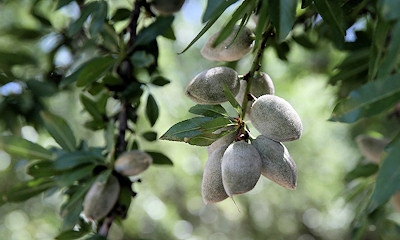March 30, 2016

Farmers have long joked that climate change wouldn't be such a bad thing - especially for northern farmers who could raise longer-season corn or soybeans. And while they may have said it tongue -in-cheek, new work by University of Idaho researchers shows projections of future hardiness zones could change the crop mix.

CROPS MOVING NORTH: New University of Idaho research shows changing hardiness zones. Could almonds be grown in Oregon? (Photo: Justin Sullivan/Getty Images)
The researchers used climate models to assess how the coldest temperature recorded each winter in the United States might change over the next several decades, and what these temperature changes might mean for horticulture. The study, published in Environmental Research Letters, was funded by Regional Approaches to Climate Change, or REACCH, a USDA National Institute of Food and Agriculture project led by UI.
USDA uses multi-year averages of annual coldest temperature to assign cold hardiness zones, and growers uses these numbers to gauge which crops will survive in a particular area. The UI researchers' model predicts the annual coldest temperature will climb, as will overall average winter temperatures. Other studies have shown that average minimum temperatures have been showing warming trends in the 20th Century, but this new study shows extreme lows will rise faster.
Lauren Parker, doctoral candidate in geography, and the study's lead author, notes that these rising temperatures will result in a widespread change in U.S. hardiness zones in response. For example, in the Northern Plains this shift will happen faster than in others, such as along the Pacific Coast, she notes.
Adds Parker: “When farmers are thinking about their long-term planting and management strategies, this would be something to keep in mind. Our projections are for midcentury, so if you’re a young farmer just starting out, by the time you’re passing your farm along to the next generation, if not before, you may be seeing some of these changes.”
For example, almonds might be raised in Oregon, or oranges could move into Louisiana. Warming of the annual coldest temperatures could allow for an expansion of areas suitable for growing high-value tree crops including almonds and oranges that are currently limited by cold winter temperatures.
“Cold hardiness zones are linked to broader temperature patterns, and the warming of cold extremes and average minimum temperatures could mean new opportunities for growers,” Parker said. “If our favorite foods can be cultivated over a larger area, there may be more ability for stable food prices in years of regional drought, spring freeze or other events that impact crop yields.”
However, this warming isn't all good news as co-author John Abatzoglou, an associate professor of geography at UI explains: "While warming might allow us to grow cold-intolerant species in new areas, the lack of cold temperatures may also exacerbate problems related to pests and invasive species."
Of course there's more to growing a crop than warmer temperatures including water availability and heat stress. However, Parker says work is being done to seek ways to address these factors to provide a better piecture of how future climate may shift the geographic distribution.
Source: University of Idaho
You May Also Like




